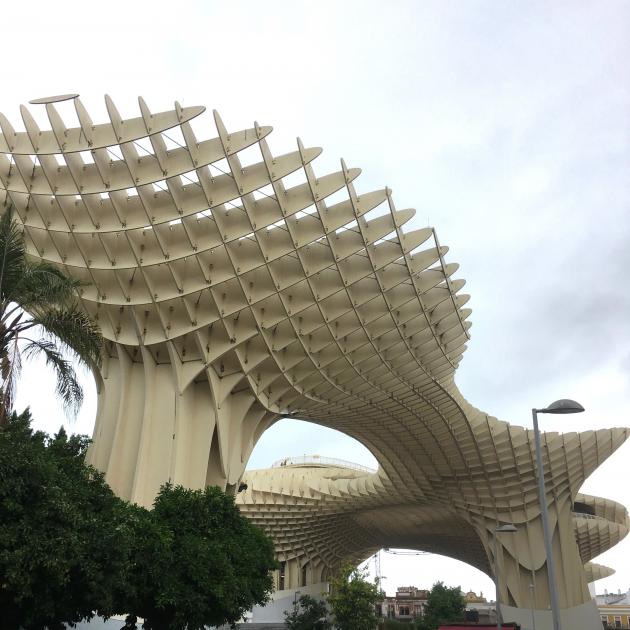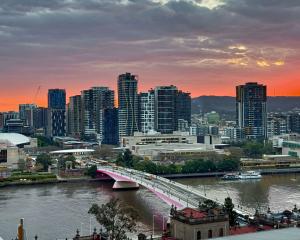
"Pay attention," I find myself saying. It seems a good mantra on the way to Seville, in southern Spain.
Famous Sevillanos poet Antonio Machado spent much of his life in the effort of attention.
Motivated to see and to listen. Attention to time. To the landscape. To the past of each city he lived, and to the way colours unfold. To synchronicity and to dreams. Machado suggested that, a secret you is present in the feelings evoked in a landscape. The landscape of Andalusia rolls on. Cattle and crops. Fertile farmland, a few olive groves.
The white Spanish grape vines breaking the green monotony in Jerez. How I wish to stop here. Famous for flamenco music and sherry, I long for fork thick, murky as molasses, prune rich Ximenez, PX branded sherry, the white Spanish grape, sun-dried, sweet and strong, but I will have to satisfy myself with sampling ex situ. There’s not time for turn-offs and tasting distractions.
It’s fitting to return from Morocco by way of Seville, the 7th-century Andalusian capital of the Moroccan empire of the Almohads. In the period known as the age of brilliance, Seville was the confluence of East and West and during this time some of its most distinctive landmarks, the Giralda, Alcazar and Torre del Oro were created.

In the 16th and 17th centuries, Seville flourished economically but as the Guadalquivir River became more difficult to navigate, its stronghold gave way to the Port of Cadiz. By the 19th century, Seville became recognised instead for its culture and architecture, becoming an integral part of the Grand Tour. On a Grand Tour of my own, I am silenced by what comes into view as the bus makes town. Instantly Seville sings out. The Moorish influence. Everywhere. The Parque de Maria Luisa, the Plaza de Espaa, an entree. I gasp and gape. Everywhere is beauty. Already Seville feels special and unique.
Washington Irving arriving here in 1828 on the steam ship Betis and said the enchanted buildings, lost in time, amazed him. The first American to achieve celebrity status as a professional writer, he was the first of many writers to find inspiration in the rich romance of the culture of Andalusia. Prosper Mrime, the creator of the novella, Carmen, was inspired here, along with Byron, Delacroix, Gautier and Dumas, to name a few.
It’s a taxi ride to Calle San Luis district and our Airbnb. Deceptively disappointing, we find it is not the exquisite historic building in the picture, but instead the one we look out on.
However, it does make for a satisfying view. Manuel, so many Manuels, this one an engineer, is to meet us but as is often the way with Airbnb — one of the most annoying features — there has to be an arranged meeting time to collect the key. It transpires that Manuel has moved out, the tiny modern apartment too small for his little family.
So we wait. Our reward, the wonderful Bar Plata just down the street. This is an old-school locals eatery. Never-mind the staunch owner, fierce wait staff or milky cup they call coffee. The doorstop white bread toasted sandwich. Coarse chunks of tomato, lettuce and ham. Has anything tasted so good? How could it not, as we sit opposite the Basilica Macarena and the ancient city wall, surrounded by the beauty of platas’ distinctive azulejo tile decor?
Seville was central in this tile industry, imitating Byzantine and Roman mosaics, with the Persian influence of floral, geometric and curvilinear motifs. We will find these decorations daily when we nosey into private patios and courtyards, in the public palaces, on monuments and along the zigzag of the Pasaje Calle Judera (passageway) within the medieval city wall. Casa de Pilatos, the most important of Seville’s grand houses features more than 150 different azulejo, one of the largest antique collections in the world.
From here it’s a short walk to the centre city district of Santa Cruz. Plaza de la Encarncin.

From here we can see the delights that lie ahead and the realisation grows that three days will not be nearly enough.
On the skyline, the Giralda, one of the world’s most famous towers and originally the minaret for the great mosque until after the Christian conquest, when it became an example of cultural amalgam. A Renaissance belfry added in 1568 blends beautifully with the ancient 1198 Moorish base. Crowned with the dramatic bronze figure Giraldillo, a woman in classical Roman attire, holding a shield and palm, representing the triumph of faith and serving the city as a weather vane.
Washington Irving states of the Cathedral Giralda, the largest Gothic structure in the world that "I do not believe I have ever felt an equal pleasure in any other monument of this kind ..." and while living in the city confessed to visiting more than once daily. "Go at dusk," he suggests.
On the south facade transept at the door of St Christopher, we stand in absolute awe.
Umbrella-clad tourists flutter below its walls like brilliantly coloured butterflies, dwarfed by the original bronze Giraldillo. Behind the walls, a peaceful patio, a courtyard of orange trees surround a Roman basin where worshippers would wash. Within, altars, art and choir stalls. A forest of columns skyward. Gargoyles, murals, organs, sculptures, stained glass, and vaults.

Serving as residence for governors, sultans, caliphs, emperors and kings has led to diverse styles, spanning Islamic and Mudejar art, Gothic, Renaissance, Baroque and subsequent 19th and 20th century movements. It’s a relief to be dismissed into the garden by our guide. All essential elements of Spanish gardening exist here: courtyards and patios, fountains and flowers, borders of those wonderful azulejo tiles and Sevillian-style ponds.

Calle Alcaiceria de la Loza, one of the prettiest shopping streets in Seville is lined with interesting and exclusive boutiques. I am drawn to Naturalmente. Akin to an ancient apothecary, this perfumery stocks a wide range of Sevillian scents, including their famed orange blossom. It’s a treat to have a tiny bottle of violet cologne distilled and bottled by the perfumer who owns this store.
I cannot believe my good fortune to stumble upon Casa de las Duenas. This late 15th-century palace built in the Renaissance style with Gothic and Moorish influences, becomes my standout in Seville. Belonging to the House of Alba and recently opened to the public by the current duke, Las Duenas encapsulates the best of Spanish architecture and style.
Once home to the eccentric Duquesa de Alba, Spain’s most famous of aristocrats, who despite owning many palaces, was happiest here. It’s a timely visit as Cayetana, as she was known to friends, was a huge fan of Holy Week, the feria and flamenco. So private and personal, to wander her rooms, view her paintings, bullfighting memorabilia and the flamboyant flamenco dresses she once wore. It is a rewarding glimpse into the privilege of Spanish nobility with 18 generations of de Alba heirlooms displayed. Described in her latter years as looking like a "Pekinese with botox", collections of family photos, reveal a younger, perhaps more satisfied, pretty self?
The Mudejar patios protect me from the heat as I linger beside pots of bright geraniums, paying attention. The Spanish style beauty of Patio de Los Limones. Imaging where visitors Jackie Kennedy, Grace Kelly and Wallis Simpson might have sat. Antonio Machado born at Las Duenas, spent a happy childhood here, making famous this courtyard with his poem, My childhood memories are of a patio in Seville, And a bright orchard where a lemon tree ripens.

As darkness descends, central Seville is deserted and we find ourselves alone at our favourite tapas bar. Our last meal in Spain, memorable. The stewed oxtail in crispy filo and grilled Pluma Iberica pork with curry oil, pumpkin and fried rocket. Superb. Our English-speaking waiter offers directions to Triana, across the Guadalquivir River, explaining that all we need to do is follow the drifting crowds. Boarding a bus with costume-clad Spaniards in festival mood, a circuitous route, endless stops, eventually leads us to the feria’s sparkling entrance.
You must know how to dance the Sevillanas, the folk dance that any Sevillanos will naturally know. And drink rebujitos cocktails (a mix of Manzanilla sherry and 7 up) while sharing tapas.
Round off the night with churros and chocolate. Then repeat, six evenings more.
It seems an age to stand alone waiting until midnight for the lights of the portada (entrance) to be officially turned on, so we opt for a taxi back to town before the other 850,000 guests begin their urban drift.
In the brightness of the morning, the streets are full of flamenco-clad Sevillanos. Joining in the festive spirit, we head to Bar Plata, squeezing out our final fill of culture and architecture.
There are intensely happy memories ... ... of a patio in Seville, and a bright orchard where a lemon tree ripens.












